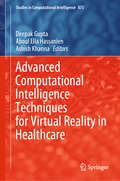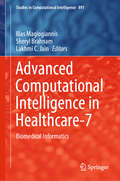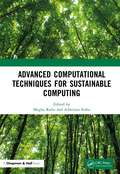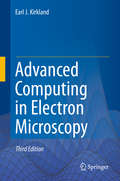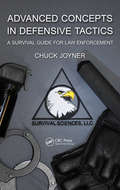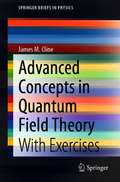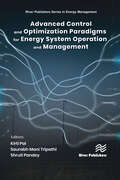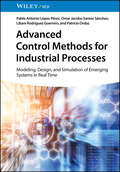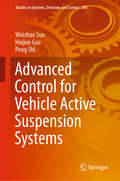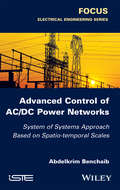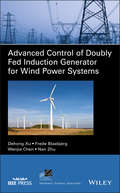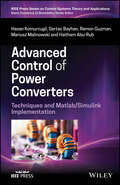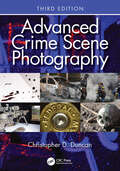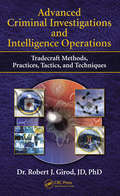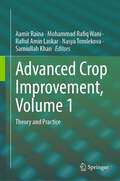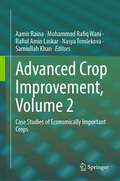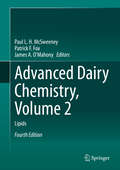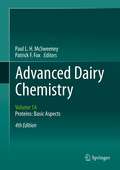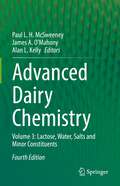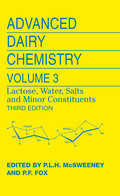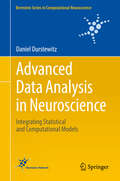- Table View
- List View
Advanced Computational Fluid and Aerodynamics
by Tucker Paul G.The advent of supercomputers has brought computational fluid dynamics (CFD) to the forefront as a tool to analyze increasingly complex simulation scenarios in many fields. Computational aerodynamics problems are also increasingly moving towards being coupled, multi-physics and multi-scale with complex, moving geometries. The latter presents severe geometry handling and meshing challenges. Simulations also frequently use formal design optimization processes. This book explains the evolution of CFD and provides a comprehensive overview of the plethora of tools and methods available for solving complex scenarios while exploring the future directions and possible outcomes. Using numerous examples, illustrations and computational methods the author discusses turbulence modeling, pre and post processing, coupled solutions, the importance of design optimization, multiphysics problems, reduced order models, and large scale computations and the future of CFD. Advanced Computational Fluid and Aerodynamics is suitable for audiences engaged in computational fluid dynamics including advanced undergraduates, researchers and industrial practitioners.
Advanced Computational Intelligence Techniques for Virtual Reality in Healthcare (Studies in Computational Intelligence #875)
by Aboul Ella Hassanien Deepak Gupta Ashish KhannaThis book addresses the difficult task of integrating computational techniques with virtual reality and healthcare. It discusses the use of virtual reality in various areas, such as healthcare, cognitive and behavioural training, understanding mathematical graphs, human–computer interaction, fluid dynamics in healthcare industries, accurate real-time simulation, and healthcare diagnostics.Presenting the computational techniques for virtual reality in healthcare, it is a valuable reference resource for professionals at educational institutes as well as researchers, scientists, engineers and practitioners in industry.
Advanced Computational Intelligence in Healthcare-7: Biomedical Informatics (Studies in Computational Intelligence #891)
by Lakhmi C. Jain Sheryl Brahnam Ilias MaglogiannisThis book presents state-of-the-art works and systematic reviews in the emerging field of computational intelligence (CI) in electronic health care. The respective chapters present surveys and practical examples of artificial intelligence applications in the areas of Human-Machine Interface (HMI) and affective computing, machine learning, big health data and visualization analytics, computer vision and medical image analysis. The book also addresses new and emerging topics in CI for health care such as the utilization of Social Media (SM) and the introduction of new intelligent paradigms in the security and privacy domains, which are critical for the health sector. The chapters, while of course not exhaustively addressing all the possible aspects of the aforementioned areas, are indicative of the dynamic nature of interdisciplinary research being pursued. Accordingly, the book is intended not only for researchers in the respective fields, but also for medical and administrative personnel working in the health sector, as well as managers and stakeholders responsible for making strategic decisions and defining public health policies.
Advanced Computational Techniques for Sustainable Computing
by Megha RathiAdvanced Computational Techniques for Sustainable Computing is considered multi-disciplinary field encompassing advanced computational techniques across several domain, including, Computer Science, Statistical Computation and Electronics Engineering. The core idea of sustainable computing is to deploy algorithms, models, policies and protocols to improve energy efficiency and management of resources, enhancing ecological balance, biological sustenance and other services on societal contexts. The book offers comprehensive coverage of the most essential topics, and: Provides insight on building smart sustainable solutions Includes details of applying mining, learning, IOT and sensor-based techniques for sustainable computing Entails data extraction from various sources followed with pre-processing of data, and how to make effective use of extracted data for application-based research Involves practical usage of data analytic language, including R, Python, etc. for improving sustainable services offered by multi-disciplinary domains Encompasses comparison and analysis of recent technologies and trends Includes development of smart models for information gain and effective decision making with visualization The readers would get acquainted with the utilization of massive data sets for intelligent mining and processing. It includes the integration of data mining techniques for effective decision-making in the social, economic, and global environmental domains to achieve sustainability. The implementation of computational frameworks can be accomplished using open-source software for the building of resource-efficient models. The content of the book demonstrates the usage of data science and the internet of things for the advent of smart and realistic solutions for attaining sustainability.
Advanced Computational Vibroacoustics
by Roger OhayonAdvanced Computational Vibroacoustics presents an advanced computational method for the prediction of sound and structural vibrations, in low- and medium-frequency ranges - complex structural acoustics and fluid-structure interaction systems encountered in aerospace, automotive, railway, naval, and energy-production industries. The formulations are presented within a unified computational strategy and are adapted for the present and future generation of massively parallel computers. A reduced-order computational model is constructed using the finite element method for the damped structure and the dissipative internal acoustic fluid (gas or liquid with or without free surface) and using an appropriate symmetric boundary-element method for the external acoustic fluid (gas or liquid). This book allows direct access to computational methods that have been adapted for the future evolution of general commercial software. Written for the global market, it is an invaluable resource for academic researchers, graduate students, and practising engineers.
Advanced Computing in Electron Microscopy
by Earl J. KirklandThis updated and revised edition of a classic work provides a summary of methods for numerical computation of high resolution conventional and scanning transmission electron microscope images. At the limits of resolution, image artifacts due to the instrument and the specimen interaction can complicate image interpretation. Image calculations can help the user to interpret and understand high resolution information in recorded electron micrographs. The book contains expanded sections on aberration correction, including a detailed discussion of higher order (multipole) aberrations and their effect on high resolution imaging, new imaging modes such as ABF (annular bright field), and the latest developments in parallel processing using GPUs (graphic processing units), as well as updated references. Beginning and experienced users at the advanced undergraduate or graduate level will find the book to be a unique and essential guide to the theory and methods of computation in electron microscopy.
Advanced Concepts in Defensive Tactics: A Survival Guide for Law Enforcement
by Chuck JoynerThis ground breaking book is the first law enforcement defensive tactics publication that realistically addresses the limited training that law enforcement officers currently receive. This book concentrates on avoiding the initial attack, moving to safety, deploying a secondary weapon, and surviving the attack. Concepts are based upon extensive research, a landmark study by the International Association of Chiefs of Police, and street experience. The book stresses core concepts, proper body mechanics, and proven survival principles. Each chapter ends with drills to increase mental awareness, physical skills, and survivability tips.
Advanced Concepts in Particle and Field Theory
by Tristan HübschUniting the usually distinct areas of particle physics and quantum field theory, gravity and general relativity, this expansive and comprehensive textbook of fundamental and theoretical physics describes the quest to consolidate the basic building blocks of nature, by journeying through contemporary discoveries in the field, and analyzing elementary particles and their interactions. Designed for advanced undergraduates and graduate students and abounding in worked examples and detailed derivations, as well as including historical anecdotes and philosophical and methodological perspectives, this textbook provides students with a unified understanding of all matter at the fundamental level. Topics range from gauge principles, particle decay and scattering cross-sections, the Higgs mechanism and mass generation, to spacetime geometries and supersymmetry. By combining historically separate areas of study and presenting them in a logically consistent manner, students will appreciate the underlying similarities and conceptual connections to be made in these fields.
Advanced Concepts in Quantum Field Theory: With Exercises (SpringerBriefs in Physics)
by James M. ClineThis book comprises the second half of a quantum field theory (QFT) course for graduate students. It gives a concise introduction to advanced concepts that are important for research in elementary particle theory. Topics include the path integral, loop expansion, Feynman rules, various regularization methods, renormalization, running couplings and the renormalization group, fixed points and asymptotic freedom, effective action, Coleman-Weinberg effective potential, fermions, the axial anomaly, QED, gauge fixing, nonabelian gauge theories, unitarity, optical theorem, Slavnov-Taylor identities, beta function of Yang-Mills theory, a heuristic derivation of asymptotic freedom, instantons in SU(N) gauge theory, theta vacua and the strong CP problem. Exercises are included and are intended for advanced graduate students or postdocs seeking to deepen their understanding of QFT.
Advanced Concepts in Quantum Mechanics
by Gennaro Miele Giampiero Esposito Giuseppe Marmo George SudarshanIntroducing a geometric view of fundamental physics, starting from quantum mechanics and its experimental foundations, this book is ideal for advanced undergraduate and graduate students in quantum mechanics and mathematical physics. Focusing on structural issues and geometric ideas, this book guides readers from the concepts of classical mechanics to those of quantum mechanics. The book features an original presentation of classical mechanics, with the choice of topics motivated by the subsequent development of quantum mechanics, especially wave equations, Poisson brackets and harmonic oscillators. It also presents new treatments of waves and particles and the symmetries in quantum mechanics, as well as extensive coverage of the experimental foundations.
Advanced Control & Optimization Paradigms for Energy System Operation and Management
by Kirti Pal Saurabh Mani Tripathi Shruti PandeyDistributed energy technologies are gaining popularity nowadays; however, due to the highly intermittent characteristics of distributed energy resources, a larger penetration of these resources into the distribution grid network becomes of major concern. The main issue is to cope with the intermittent nature of the renewable sources alongside the requirements for power quality and system stability. Unlike traditional power systems, the control and optimization of complex energy systems comprising of wind, solar, thermal, and energy storage becomes difficult in many aspects, such as modelling, integration, operation, coordination and planning etc. This means that energy conversion as per the standards imposed by the energy market is unachievable without adequate control, management, and optimization.This edited book serves as a resource for the engineers, scientists and professionals working on distributed energy systems. The book is an extensive collection of state-of-the-art studies on advanced control paradigms for complex energy systems, with emphasis on the optimization and management of the high penetration of distributed energy resources into power distribution networks. Readers will find the book inspiring and useful whilst carrying out their own research in distributed energy systems.Key features • An extensive collection of state-of-the-art studies on advanced control paradigms for complex energy systems.• Emphasis on the optimization and management of high penetration of distributed energy resources into power/energy distribution networks.• Serves as a valuable resource for engineers, scientists, academicians, experienced professionals, and research scholars who are working in management of energy systems.
Advanced Control Methods for Industrial Processes: Modeling, Design, and Simulation of Emerging Systems in Real Time
by Pablo A. López-Pérez Omar Jacobo Santos Sánchez Liliam Rodríguez Guerrero Patricio OrdazA detailed introduction to mathematical models for new and established control engineers Control engineering is a system that helps us understand electrical, physical, chemical, and biochemical systems through the use of mathematical modeling, using inputs, outputs, and simulations. These experimental platforms are implemented in most systems of modern advanced control engineering. Advanced Control Methods for Industrial Processes provides a solid grounding in traditional control techniques. It emphasizes practical application methods alongside the underlying theory and core instrumentation. Each chapter discusses the full profile of the technology covered, from the field layer and control layer to its implementation. It also includes the interfaces for advanced control systems: between controllers and systems theory, between different layers, and between operators-systems. Through an emphasis on the practical issues of components, devices, and hardware circuits, the book offers working principles and operation mechanisms that allow an engineer to put theory into practice for the advanced control techniques. Advanced Control Methods for Industrial Processes readers will also find: A practical overview on advanced control methods applied to real-time and in-silico systems Specific parameters, install procedures, calibration and configuration methodologies necessary to conduct the relevant models Clear insights into the necessary mathematical models Tutorial material to facilitate the understanding of core concepts Advanced Control Methods for Industrial Processes is an ideal companion for process engineers, control engineers, and chemists in industry.
Advanced Control for Vehicle Active Suspension Systems (Studies in Systems, Decision and Control #204)
by Huijun Gao Peng Shi Weichao SunThis book focuses on most recent theoretical findings on control issues for active suspension systems. The authors first introduce the theoretical background of active suspension control, then present constrained H∞ control approaches of active suspension systems in the entire frequency domain, focusing on the state feedback and dynamic output feedback controller in the finite frequency domain which people are most sensitive to. The book also contains nonlinear constrained tracking control via terminal sliding-mode control and adaptive robust theory, presenting controller design of active suspensions as well as the reliability control of active suspension systems. The target audience primarily comprises research experts in control theory, but the book may also be beneficial for graduate students alike.
Advanced Control of AC/DC Power Networks
by Abdelkrim BenchaibThe concept of Multi-Terminal DC grids (MTDC), where DC cables connect more than two AC/DC converter stations is nowadays spreading driven by different criteria, all necessaries for large-capacity RES grid integration, such as larger flexibility of grid operation, possibility of reversible power flows, increased redundancy, and reduction of maximum power loss in case of a grid disturbance.
Advanced Control of Doubly Fed Induction Generator for Wind Power Systems (IEEE Press Series on Power Engineering)
by Frede Blaabjerg Nan Zhu Dehong Xu Wenjie ChenCovers the fundamental concepts and advanced modelling techniques of Doubly Fed Induction Generators accompanied by analyses and simulation results Filled with illustrations, problems, models, analyses, case studies, selected simulation and experimental results, Advanced Control of Doubly Fed Induction Generator for Wind Power Systems provides the basic concepts for modelling and controlling of Doubly Fed Induction Generator (DFIG) wind power systems and their power converters. It explores both the challenges and concerns of DFIG under a non-ideal grid and introduces the control strategies and effective operations performance options of DFIG under a non-ideal grid. Other topics of this book include thermal analysis of DFIG wind power converters under grid faults; implications of the DFIG test bench; advanced control of DFIG under harmonic distorted grid voltage, including multiple-loop and resonant control; modeling of DFIG and GSC under unbalanced grid voltage; the LFRT of DFIG, including the recurring faults ride through of DFIG; and more. In addition, this resource: Explores the challenges and concerns of Doubly Fed Induction Generators (DFIG) under non-ideal grid Discusses basic concepts of DFIG wind power system and vector control schemes of DFIG Introduces control strategies under a non-ideal grid Includes case studies and simulation and experimental results Advanced Control of Doubly Fed Induction Generator for Wind Power Systems is an ideal book for graduate students studying renewable energy and power electronics as well as for research and development engineers working with wind power converters.
Advanced Control of Power Converters: Techniques and Matlab / Simulink Implementation (IEEE Press Series on Control Systems Theory and Applications)
by Haitham Abu-Rub Mariusz Malinowski Sertac Bayhan Hasan Komurcugil Ramon GuzmanAdvanced Control of Power Converters Unique resource presenting advanced nonlinear control methods for power converters, plus simulation, controller design, analyses, and case studies Advanced Control of Power Converters equips readers with the latest knowledge of three control methods developed for power converters: nonlinear control methods such as sliding mode control, Lyapunov-function-based control, and model predictive control. Readers will learn about the design of each control method, and simulation case studies and results will be presented and discussed to point out the behavior of each control method in different applications. In this way, readers wishing to learn these control methods can gain insight on how to design and simulate each control method easily. The book is organized into three clear sections: introduction of classical and advanced control methods, design of advanced control methods, and case studies. Each control method is supported by simulation examples along with Simulink models which are provided on a separate website. Contributed to by five highly qualified authors, Advanced Control of Power Converters covers sample topics such as: Mathematical modeling of single- and three-phase grid-connected inverter with LCL filter, three-phase dynamic voltage restorer, design of sliding mode control and switching frequency computation under single- and double-band hysteresis modulations Modeling of single-phase UPS inverter and three-phase rectifier and their Lyapunov-function-based control design for global stability assurance Design of model predictive control for single-phase T-type rectifier, three-phase shunt active power filter, three-phase quasi-Z-source inverter, three-phase rectifier, distributed generation inverters in islanded ac microgrids How to realize the Simulink models in sliding mode control, Lyapunov-function-based control and model predictive control How to build and run a real-time model as well as rapid prototyping of power converter by using OPAL-RT simulator Advanced Control of Power Converters is an ideal resource on the subject for researchers, engineering professionals, and undergraduate/graduate students in electrical engineering and mechatronics; as an advanced level book, and it is expected that readers will have prior knowledge of power converters and control systems.
Advanced Crime Scene Photography
by Christopher D. DuncanThe ability to thoroughly and accurately photograph a crime scene is a mandate for all investigators, regardless of the time of day, weather conditions, or confines within which a piece of evidence is concealed. Evidence is commonly found in locations that are some of the most difficult to access and photograph. Having the knowledge, wherewithal, and skills necessary to photograph evidence in less-than-accommodating environments is vital to a photographer’s effectiveness and success. Advanced Crime Scene Photography, Third Edition takes a somewhat different approach to the subject over prior editions. Rather than assuming a crime scene investigator’s or photographer’s comfort with the operation of their cameras—and a basic understanding of apertures, shutter speeds, ISO values, and basic exposure calculations—the author has added coverage to provide a thorough review of basic photographic concepts, as a refresher to readers. And, for those less familiar or otherwise new to photography, such background makes the foundational concepts more understandable for those readers who require such information to understand the more advanced techniques covered later in the book. In addition to this background coverage, an entirely new chapter has been added to provide essential guidance on how to prepare and testify in court. Anyone with a camera phone can take a photograph in perfect lighting, with the subject sitting out in the open, and already positioned for the best composition. This book provides crime scene photographers with the skills necessary to record those same beautiful photographs in adverse condition, surrounded by tragedy, utilizing all the tools available to the investigator. The greatest tool a photographer has available to them is their brain. From start to finish, the value of quality crime scene photographs cannot be overemphasized; photographers must take control of their photographic endeavors, identify the challenges, design a plan to capture the image correctly, and then execute that plan. As such Advanced Crime Scene Photograph, Third Edition is written to help photographers achieve the goal of capturing the best possible images—especially in those difficult-to-capture, real-world environments and conditions—for utilization in capture illustrative images as admissible evidence and for usage in court. All photographers need to practice their craft, whether they are actively working cases as seasoned veterans or are just beginning their careers. This book provides the knowledge and skills essential to achieve career and professional success in crime scene photography.
Advanced Criminal Investigations and Intelligence Operations: Tradecraft Methods, Practices, Tactics, and Techniques
by Robert J GirodTradecraft is a term used within the intelligence community to describe the methods, practices, and techniques used in espionage and clandestine investigations. Whether the practitioner is a covert agent for the government or an identity thief and con man, the methods, practices, tactics, and techniques are often the same and sometimes learned from
Advanced Crop Improvement, Volume 1: Theory and Practice
by Aamir Raina Mohammad Rafiq Wani Rafiul Amin Laskar Nasya Tomlekova Samiullah KhanAs per the reports of FAO, the human population will rise to 9 billion by the end of 2050 and 70% of more food must be produced over the next three decades to feed the additional population. The breeding approaches for crop improvement programs are dependent on the availability and accessibility of genetic variation, either spontaneous or induced by the mutagens. Plant breeders, agronomists, and geneticists are under constant pressure to expand food production by employing innovative breeding strategies to enhance yield, adaptability, nutrition, resistance to biotic and abiotic stresses. In conventional breeding approaches, introgression of genes in crop varieties is laborious and time-consuming. Nowadays, new innovative plant breeding techniques such as molecular breeding and plant biotechnology, supplement the traditional breeding approaches to achieve the desired goals of enhanced food production. With the advent of recent molecular tools like genomics, transgenics, molecular marker-assisted back-crossing, TILLING, Eco-TILLING, gene editing, CRISPR CAS, non-targeted protein abundant comparative proteomics, genome wide association studies have made possible mapping of important QTLs, insertion of transgenes, reduction of linkage drags, and manipulation of genome. In general, conventional and modern plant breeding approaches would be strategically ideal for developing new elite crop varieties to meet the feeding requirement of the increasing world population.This book highlights the latest progress in the field of plant breeding, and their applicability in crop improvement. The basic concept of this 2-volume work is to assess the use of modern breeding strategies in supplementing conventional breeding toward the development of elite crop varieties, for obtaining desired goals of food production.
Advanced Crop Improvement, Volume 2: Case Studies of Economically Important Crops
by Aamir Raina Mohammad Rafiq Wani Rafiul Amin Laskar Nasya Tomlekova Samiullah KhanAs per the reports of FAO, the human population will rise to 9 billion by the end of 2050 and 70% of more food must be produced over the next three decades to feed the additional population. The breeding approaches for crop improvement programs are dependent on the availability and accessibility of genetic variation, either spontaneous or induced by the mutagens. Plant breeders, agronomists, and geneticists are under constant pressure to expand food production by employing innovative breeding strategies to enhance yield, adaptability, nutrition, resistance to biotic and abiotic stresses. In conventional breeding approaches, introgression of genes in crop varieties is laborious and time-consuming. Nowadays, new innovative plant breeding techniques such as molecular breeding and plant biotechnology, supplement the traditional breeding approaches to achieve the desired goals of enhanced food production. With the advent of recent molecular tools like genomics, transgenics, molecular marker-assisted back-crossing, TILLING, Eco-TILLING, gene editing, CRISPR CAS, non-targeted protein abundant comparative proteomics, genome wide association studies have made possible mapping of important QTLs, insertion of transgenes, reduction of linkage drags, and manipulation of genome. In general, conventional and modern plant breeding approaches would be strategically ideal for developing new elite crop varieties to meet the feeding requirement of the increasing world population.This book highlights the latest progress in the field of plant breeding, and their applicability in crop improvement. The basic concept of this 2-volume work is to assess the use of modern breeding strategies in supplementing the conventional breeding toward the development of elite crop varieties, for obtaining desired goals of food production.
Advanced Dairy Chemistry, Volume 2: Lipids
by Patrick F. Fox Paul L. H. McSweeney James A. O’MahonyThe Advanced Dairy Chemistry series was first published in four volumes in the 1980s (under the title Developments in Dairy Chemistry) and revised in three volumes in the 1990s and 2000s. The series is the leading reference on dairy chemistry, providing in-depth coverage of milk proteins, lipids, lactose, water and minor constituents.Advanced Dairy Chemistry Volume 2: Lipids, Fourth Edition, is unique in the literature on milk lipids, a broad field that encompasses a diverse range of topics, including synthesis of fatty acids and acylglycerols, compounds associated with the milk fat fraction, analytical aspects, behavior of lipids during processing and their effect on product characteristics, product defects arising from lipolysis and oxidation of lipids, as well as nutritional significance of milk lipids.In the years since the publication of the third edition there have been significant developments in milk lipids and these are reflected in changes to this volume. Most topics included in the third edition are retained in the current edition, which has been updated; in some cases, new authors have given their perspective on certain topics. Chapters on nutritional significance of dairy lipids have been considerably revised.This authoritative work summarizes current knowledge on milk lipids and suggests areas for further work. It will be very valuable to dairy scientists, chemists and others working in dairy research or in the dairy industry.
Advanced Dairy Chemistry: Volume 1A: Proteins: Basic Aspects, 4th Edition
by Patrick F. Fox Paul L. McsweeneyProfessor Fox’s multi-volume Advanced Dairy Chemistry set was first published in four volumes in the early 1980s. A second edition came out in the early 1990s, and an updated third edition was published a decade later. The set is the leading major reference on dairy chemistry, providing in-depth coverage of milk proteins, lipids, and lactose. The editors propose beginning the revision cycle again, with a revised first volume on proteins, to be divided and published separately as Volume 1A - Proteins: Basics Aspects, and Volume 1B – Applied Aspects. Fox and his co-editor, Paul McSweeney, have created an extensively revised the Table of Contents for Volume 1A, which details the novel and updated chapters to be included in this upcoming fourth edition. New contributors include highly regarded dairy scientists and scholars from around the world.
Advanced Dairy Chemistry: Volume 3: Lactose, Water, Salts and Minor Constituents
by Paul L. H. McSweeney James A. O’Mahony Alan L. KellyThe Advanced Dairy Chemistry series was first published in four volumes in the 1980s (under the title Developments in Dairy Chemistry) and revised in three volumes in the late 1990s and again in the 2000s and 2010s. For nearly four decades, the series has been the leading reference source on dairy chemistry and is now in its fourth edition. Advanced Dairy Chemistry Volume 3: Lactose, Water, Salts, and Minor Constituents, fourth edition, reviews the extensive literature on lactose and its significance in milk products. This volume also reviews the literature on milk salts, vitamins, and the behaviour of water in dairy products and the physical properties of milk. Most topics covered in the third edition are retained in the current edition, which has been updated and expanded considerably. New chapters cover chemically and enzymatically prepared derivatives of lactose and oligosaccharides indigenous to milk and some chapters from earlier editions are consolidated.
Advanced Dairy Chemistry: Volume 3: Lactose, Water, Salts and Minor Constituents
by Patrick F. Fox Paul L. McSweeneyThe Advanced Dairy Chemistry series was first published in four volumes in the 1980s (under the title Developments in Dairy Chemistry) and revised in three volumes in the 1990s. The series is the leading reference source on dairy chemistry, providing in-depth coverage of milk proteins, lipids, lactose, water and minor constituents. Advanced Dairy Chemistry Volume 3: Lactose, Water, Salts, and Minor Constituents, Third Edition, reviews the extensive literature on lactose and its significance in milk products. This volume also reviews the literature on milk salts, vitamins, milk flavors and off-flavors and the behaviour of water in dairy products. Most topics covered in the second edition are retained in the current edition, which has been updated and expanded considerably. New chapters cover chemically and enzymatically prepared derivatives of lactose and oligosaccharides indigenous to milk. P.L.H. McSweeney Ph.D. is Associate Professor of Food Chemistry and P.F. Fox Ph.D., D.Sc. is Professor Emeritus of Food Chemistry at University College, Cork, Ireland.
Advanced Data Analysis in Neuroscience: Integrating Statistical and Computational Models (Bernstein Series in Computational Neuroscience)
by Daniel DurstewitzThis book is intended for use in advanced graduate courses in statistics / machine learning, as well as for all experimental neuroscientists seeking to understand statistical methods at a deeper level, and theoretical neuroscientists with a limited background in statistics. It reviews almost all areas of applied statistics, from basic statistical estimation and test theory, linear and nonlinear approaches for regression and classification, to model selection and methods for dimensionality reduction, density estimation and unsupervised clustering. Its focus, however, is linear and nonlinear time series analysis from a dynamical systems perspective, based on which it aims to convey an understanding also of the dynamical mechanisms that could have generated observed time series. Further, it integrates computational modeling of behavioral and neural dynamics with statistical estimation and hypothesis testing. This way computational models in neuroscience are not only explanat ory frameworks, but become powerful, quantitative data-analytical tools in themselves that enable researchers to look beyond the data surface and unravel underlying mechanisms. Interactive examples of most methods are provided through a package of MatLab routines, encouraging a playful approach to the subject, and providing readers with a better feel for the practical aspects of the methods covered. "Computational neuroscience is essential for integrating and providing a basis for understanding the myriads of remarkable laboratory data on nervous system functions. Daniel Durstewitz has excellently covered the breadth of computational neuroscience from statistical interpretations of data to biophysically based modeling of the neurobiological sources of those data. His presentation is clear, pedagogically sound, and readily useable by experts and beginners alike. It is a pleasure to recommend this very well crafted discussion to experimental neuroscientists as well as mathematically well versed Physicists. The book acts as a window to the issues, to the questions, and to the tools for finding the answers to interesting inquiries about brains and how they function. " Henry D. I. Abarbanel Physics and Scripps Institution of Oceanography, University of California, San Diego "This book delivers a clear and thorough introduction to sophisticated analysis approaches useful in computational neuroscience. The models described and the examples provided will help readers develop critical intuitions into what the methods reveal about data. The overall approach of the book reflects the extensive experience Prof. Durstewitz has developed as a leading practitioner of computational neuroscience. " Bruno B. Averbeck

